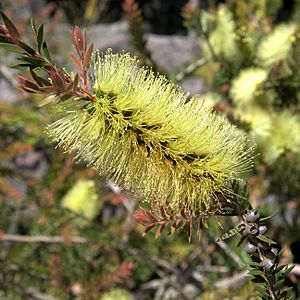Lime bottlebrush facts for kids
Quick facts for kids Lime bottlebrush |
|
|---|---|
 |
|
| M. virens flowers, fruit and new growth | |
| Scientific classification | |
| Genus: |
Melaleuca
|
| Species: |
virens
|
| Synonyms | |
|
|
The lime bottlebrush, also known as Melaleuca virens, is a special plant found only in Tasmania, Australia. It belongs to the myrtle family, called Myrtaceae. This plant is one of only two types of melaleuca that grow naturally only in Tasmania.
This plant is a small to medium-sized shrub. It often grows in mountain areas where it can be quite cold. It has tough, leathery leaves with sharp points. In early summer, you can see its spikes of yellow or greenish flowers.
What Does It Look Like?
The lime bottlebrush is a shrub that can grow up to about 3 m (10 ft) tall. Its leaves are arranged one after another along the stem. They are usually between 14 and 37 mm (0.5 to 1.5 in) long and 1.8 to 5 mm (0.07 to 0.2 in) wide. The leaves are flat and shaped like a narrow oval, sometimes a bit curved. They always end in a sharp point. You can see the main vein and tiny oil glands on both sides of the leaves.
The flowers are yellow or greenish-yellow. They grow in spikes at the ends of branches, and sometimes on the sides too. After the flowers bloom, the branches keep growing. Each flower spike is about 30 to 50 mm (1.2 to 2 in) across and 40 to 60 mm (1.6 to 2.4 in) long. Each spike can have between 20 and 80 individual flowers.
The petals of the flowers are small, about 2.7 to 4.9 mm (0.1 to 0.2 in) long. They fall off as the flower gets older. Each flower has 19 to 36 stamens, which are the parts that produce pollen. These stamens sometimes grow in groups of five. The plant usually flowers from November to May. After flowering, it produces woody capsules, which are like small, hard seed pods. These capsules are about 4.5 to 6 mm (0.18 to 0.24 in) long.
Its Name and History
The lime bottlebrush was first described in 1825 by a scientist named John Sims. He saw a plant that grew from a seed at a nursery in Fulham. The description was published in a magazine called Curtis's Botanical Magazine.
A year later, in 1826, another botanist named Robert Sweet changed its name to Callistemon viridiflorus. Then, in 2006, Lyndley Craven changed the name again to Melaleuca virens. This name is now accepted by many plant experts around the world.
The second part of the plant's scientific name, virens, comes from a Latin word, viridis. This word means "green," which refers to the green color of the flowers.
Where Does It Grow?
You can find Melaleuca virens all over Tasmania. However, it is more common in wet areas, especially in the mountains or colder parts of the state. It likes to grow in swamps, in areas with low-growing shrubs called heath, and on plains covered with a type of grass called buttongrass.

